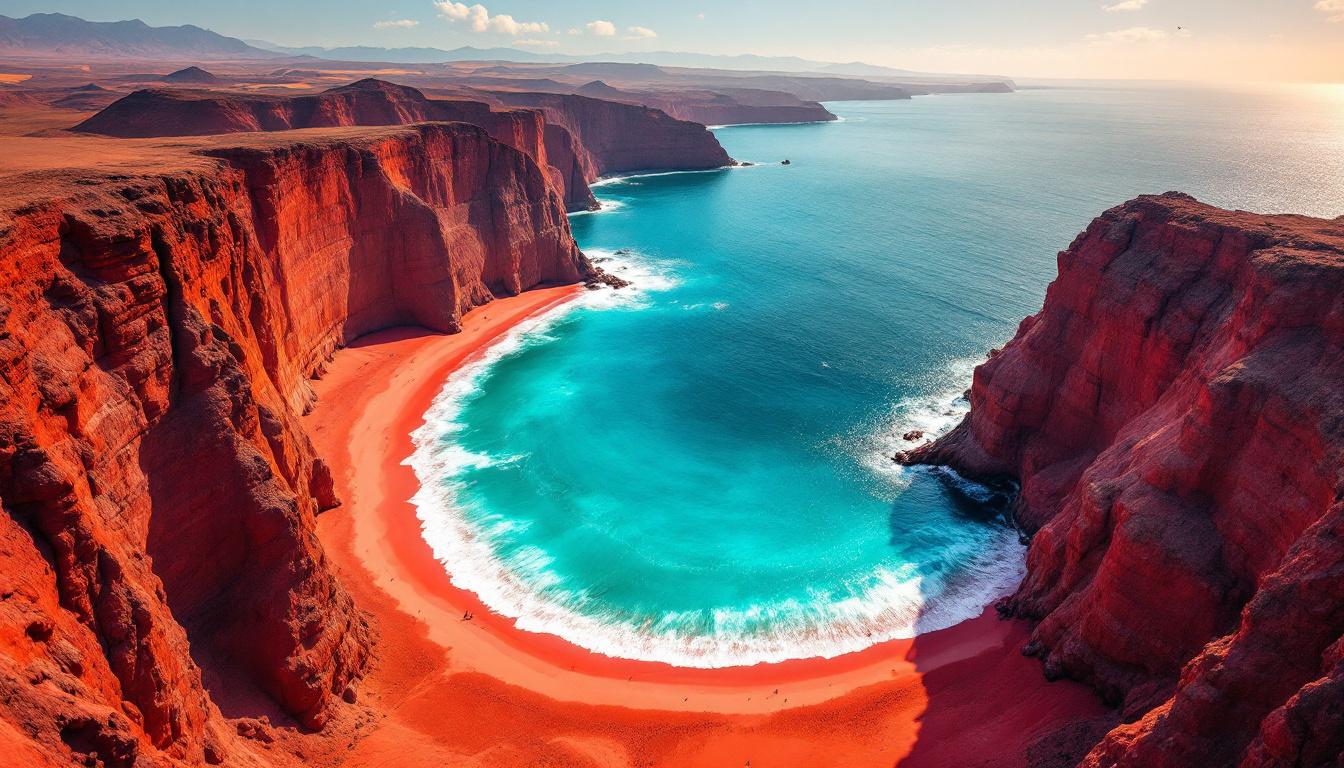Along Peru’s rugged southern coast, where the Atacama Desert meets the Pacific Ocean, lies a beach so small you could walk its entire length in under five minutes. Playa Roja stretches just 300 meters—shorter than three city blocks—yet this tiny stretch of coastline holds a geological secret that transforms ordinary beach sand into something extraordinary.
The moment you crest the final ridge in Paracas National Reserve, the sight stops you cold. Instead of Peru’s typical golden shores, a ribbon of deep crimson sand curves against turquoise waters. Locals simply call it “Playa Roja”—Red Beach—but whisper that it’s “South America’s secret Maldives” when they think tourists aren’t listening.
This volcanic phenomenon exists because ancient eruptions deposited pink granodiorite rocks along this isolated coastline. Millennia of Pacific waves ground these iron oxide-rich stones into the finest red sand, creating Peru’s only beach of this color. The result is so striking that many visitors initially think the sand has been artificially colored.
The intimate scale that creates pure magic
A beach smaller than most city parks
At exactly 300 meters long and 50 meters wide, Playa Roja is dwarfed by famous beaches worldwide. Yet this tiny scale creates an intimacy impossible at sprawling resorts. Every wave feels personal, every sunset seems choreographed just for you, and the dramatic red-black cliffs that frame both ends create a natural amphitheater that amplifies the ocean’s rhythm.
Volcanic formations that dwarf the beach itself
The towering cliffs surrounding this pocket beach rise over 100 meters above the sand, their layers telling the story of volcanic activity spanning thousands of years. These ancient walls create natural windbreaks that keep the beach surprisingly sheltered, while their mineral composition continues slowly contributing to the red sand below through ongoing erosion.
Unique characteristics that defy every expectation
The only red sand beach in all of Peru
Scientific analysis reveals that Playa Roja’s distinctive coloration comes from iron oxide concentrations of over 15%—dramatically higher than typical beaches. The specific combination of pink granodiorite from ancient volcanic activity and the Humboldt Current’s unique wave patterns created conditions that exist nowhere else along Peru’s 2,500-kilometer coastline.
Waters that shift color with the light
The cold Humboldt Current brings nutrient-rich waters that appear deep turquoise against the red sand, creating color contrasts that shift dramatically throughout the day. Morning light turns the water emerald, while late afternoon sun makes it glow sapphire blue. This natural light show peaks during Peru’s dry season from May to September.
Local secrets only Paracas residents know
The protected timing that locals guard carefully
Paracas fishermen reveal that the beach’s most spectacular colors emerge during the “hora dorada”—golden hour—just before sunset. The iron oxide in the sand becomes almost luminescent, while the surrounding cliffs cast purple shadows that make the red sand appear to glow from within.
Hidden access that requires insider knowledge
Reaching Playa Roja demands a 45-minute hike from the Paracas National Reserve entrance, following unmarked trails that locals use to avoid the tourist buses heading to more accessible beaches. The path winds through desert landscapes where vicuñas graze and Andean flamingos feed in hidden salt flats, creating an adventure that builds anticipation for the crimson surprise ahead.
The authentic experience tiny places provide
Solitude impossible at famous beaches
While Copacabana hosts thousands daily, Playa Roja rarely sees more than 20 visitors at once due to its remote location and protected status. This means experiencing Peru’s most unusual beach feels like a private discovery, with only seabirds and occasional sea lions as companions along the dramatic shoreline.
Cultural preservation that mass tourism destroys
The beach’s tiny size and difficult access naturally protect it from overdevelopment. Local Paracas families who’ve fished these waters for generations actively support keeping visitor numbers low, ensuring that traditional coastal culture survives alongside this geological wonder. Their commitment to preservation means future travelers will find Playa Roja exactly as nature intended.
This tiny crimson jewel proves that Peru’s most extraordinary beaches aren’t always the largest or most accessible. Sometimes the greatest discoveries require the longest walks, and the most unforgettable memories come from places small enough to hold in your heart.
